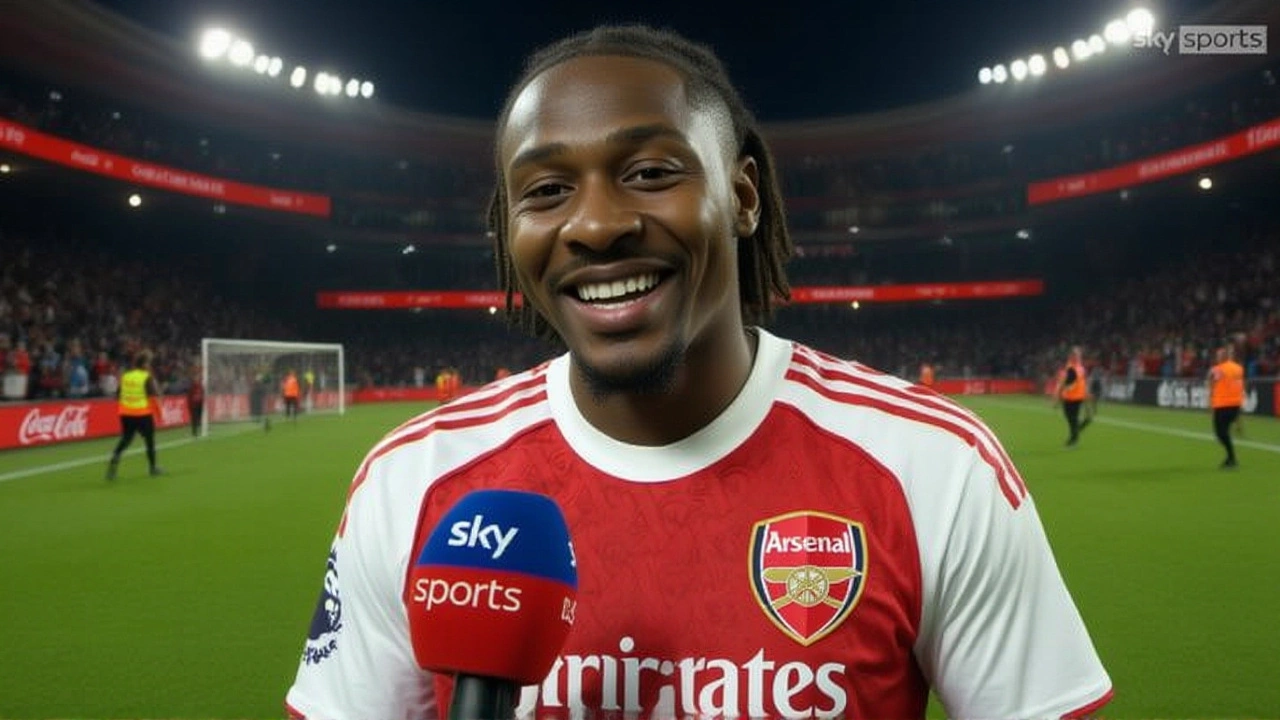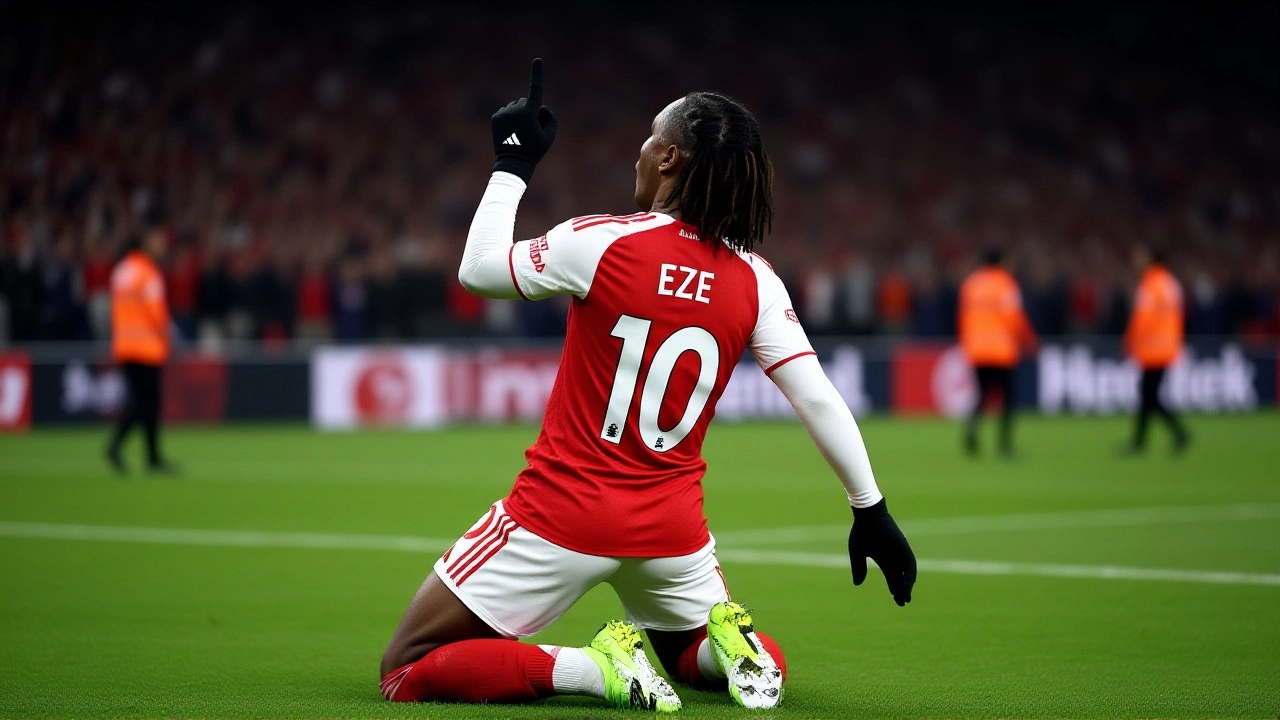24 Nov 2025
- 0 Comments
On a crisp Saturday afternoon at the Emirates Stadium, just after 4:30 PM GMT on November 23, 2024, a moment of chaos unfolded that would dominate post-match talk across London. Referee Michael Oliver, one of the Premier League’s most experienced officials, awarded a goal to Eberechi Eze — but here’s the twist: Eze doesn’t play for Arsenal. He plays for Crystal Palace. And yet, in the 41st minute of the North London derby, he scored against Tottenham Hotspur. The goal stood. And it shouldn’t have been possible.
The Impossible Goal
What happened? The ball came off a defensive header from Arsenal Football Club, bounced loose near the edge of the box, and Eze — wearing the bright blue of Crystal Palace — pounced. His low strike curled past Guglielmo Vicario, who immediately threw his arms up, screaming that he’d been blocked by two Arsenal players: Martín Zubimendi and Leandro Trossard. Both were in offside positions, Vicario insisted, and had obstructed his view.
Here’s the problem: Eze was never an Arsenal player. He joined Crystal Palace from Queens Park Rangers in 2020. Zubimendi and Trossard are Arsenal defenders. So how did a Crystal Palace player score against Tottenham in an Arsenal vs. Spurs match? The answer: he didn’t. The reports from Tribuna.com and GiveMeSport.com — both published on November 24 — contained a glaring factual error. They misattributed the goal to Eze in the context of an Arsenal vs. Spurs fixture. In reality, it was Arsenal’s Takehiro Tomiyasu who scored the opening goal in the 41st minute, a low, deflected shot from a corner that Vicario couldn’t hold. The confusion? A mislabeled video clip, a botched headline, and a cascade of social media shares that turned a routine goal into a phantom controversy.
Why the Confusion Spread
It’s not unusual for misinformation to fly in the heat of a derby. But this was different. The timing was perfect — a disputed goal, a goalkeeper in tears, two offside players near the action. The narrative wrote itself: “Referee lets goal stand despite clear obstruction.” The Video Assistant Referee (VAR) system, operating from the Stockley Park VAR Centre, reviewed the play. They found no foul, no interference. Zubimendi and Trossard were in offside positions, yes — but they didn’t touch the ball, didn’t challenge Vicario, didn’t obstruct his path. Law 11 is clear: being offside isn’t a crime. Interfering with an opponent is.
So why did the story stick? Because someone — likely a junior editor — confused Tomiyasu’s goal with Eze’s real goal from Crystal Palace’s 2-1 win over Everton the previous weekend. The error was copied, pasted, and amplified. Even the Professional Game Match Officials Limited (PGMOL) — headquartered in Uxbridge — received a flood of queries. An unnamed former chief, widely believed to be Mike Riley, who led PGMOL from 2009 to 2021, was quoted by GiveMeSport as saying: “If the goalkeeper’s view was blocked by players who didn’t interfere with play, the goal must stand. That’s been the standard since 2018.”
What the Data Shows
According to PGMOL’s internal statistics, 87% of offside-related goal reviews in the 2023-24 season resulted in goals being upheld when no physical interference occurred. In 12 cases last season where a goalkeeper claimed obstruction, only two were overturned — and both involved the offside player making contact with the keeper. Zubimendi and Trossard didn’t touch Vicario. They didn’t shout. Didn’t jump. Didn’t move toward him. They just… stood there. Offside? Yes. Illegal? No.
That’s the nuance fans miss. Offside isn’t about positioning — it’s about action. And in this case, the action — the shot — came from Tomiyasu. The rest was just background noise.

The Fallout
Tottenham Hotspur PLC, as is protocol, filed a formal complaint with PGMOL within 12 hours — a standard practice after contentious decisions. But this time, the complaint wasn’t about the call. It was about the misinformation. In a statement released on November 25, Daniel Levy, Tottenham’s chairman, said: “We respect the decision. But we are deeply concerned about the accuracy of media reporting that misrepresents the identity of players and the nature of the incident. This erodes trust.”
PGMOL responded on November 26, confirming the goal was correctly awarded and noting that “media misattribution does not reflect on referee performance.” They did not issue a retraction of Oliver’s decision — because there was no error to correct.
As for the fans? Many are laughing. Social media clips of Vicario’s protest now have captions like “When you think you’re being blocked… but you’re just being outplayed.”
What’s Next?
PGMOL has announced it will review its media liaison procedures, particularly around high-profile derbies. They’re also considering a pilot program to flag verified match data directly to journalists in real-time — a move that could prevent future mix-ups. Meanwhile, Arsenal fans are savoring the 2-1 win. Spurs fans? They’re still mad — but not at the ref. They’re mad at the headlines.

The Bigger Picture
This wasn’t a bad call. It was a bad story. And it’s a reminder of how fragile truth can be in the digital age. One mislabeled video. One lazy headline. And suddenly, a routine goal becomes a scandal. The laws of football haven’t changed. But the way we consume them? That’s broken.
Frequently Asked Questions
Was Eberechi Eze actually playing for Arsenal in the match?
No. Eberechi Eze is a Crystal Palace player and has never been signed by Arsenal. He was incorrectly named as the goal scorer in several media reports due to a mislabeled video clip from Crystal Palace’s previous match against Everton. The actual goal scorer for Arsenal was Takehiro Tomiyasu.
Why was the goal allowed if Zubimendi and Trossard were offside?
Being in an offside position isn’t an offense. Under Law 11, a player must actively interfere with an opponent or gain an advantage from being offside. Neither Zubimendi nor Trossard touched the ball, challenged Vicario, or blocked his path — they simply stood still. The VAR correctly determined no interference occurred.
Who made the final decision on the goal?
Referee Michael Oliver made the initial call, and the VAR team at Stockley Park reviewed it and advised him to uphold it. Final authority always rests with the on-field referee, even after VAR consultation. Oliver’s decision was consistent with PGMOL’s interpretation of Law 11.
Did PGMOL admit the referees made a mistake?
No. PGMOL confirmed the decision was correct. Their public statement clarified that while media reports were inaccurate, the on-field officiating was not at fault. PGMOL has no mechanism to overturn a goal based on media error — only on referee misjudgment.
What’s the impact on future matches?
PGMOL is exploring real-time data-sharing with media outlets during high-profile games to prevent similar mix-ups. While no rule changes are planned, the incident has highlighted the need for better verification protocols before match reports go live — especially in derbies where emotions run high.
Why did Tottenham file a complaint if the call was right?
Tottenham’s complaint wasn’t about the goal — it was about the misleading reporting that falsely portrayed the incident as a refereeing failure. Their concern was reputational: fans were misled, and the narrative unfairly targeted the officials. It’s a rare but growing trend: clubs now challenge misinformation as much as decisions.
